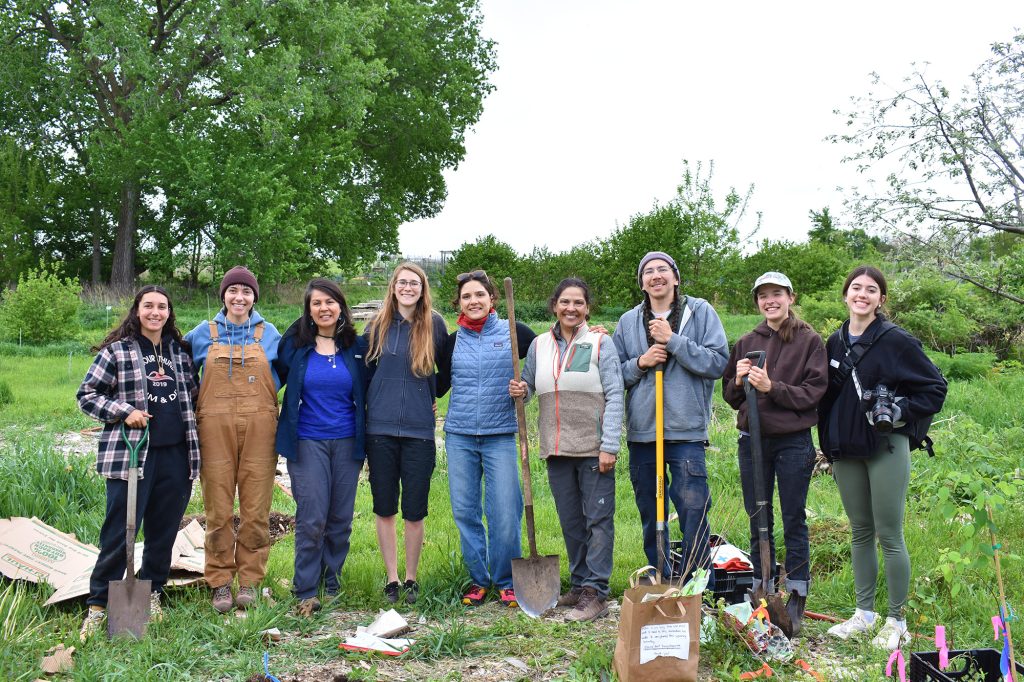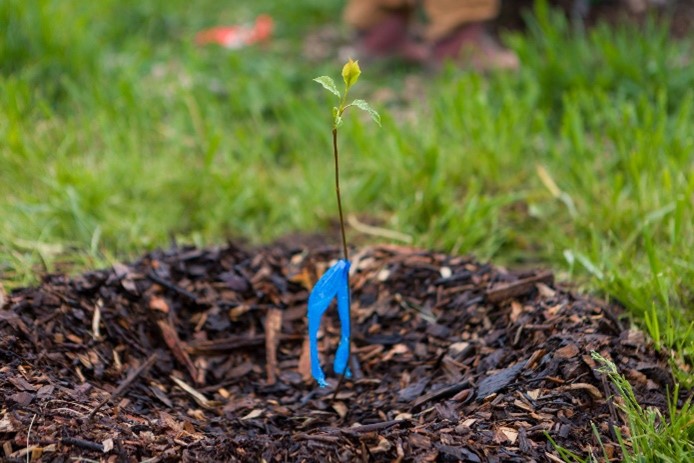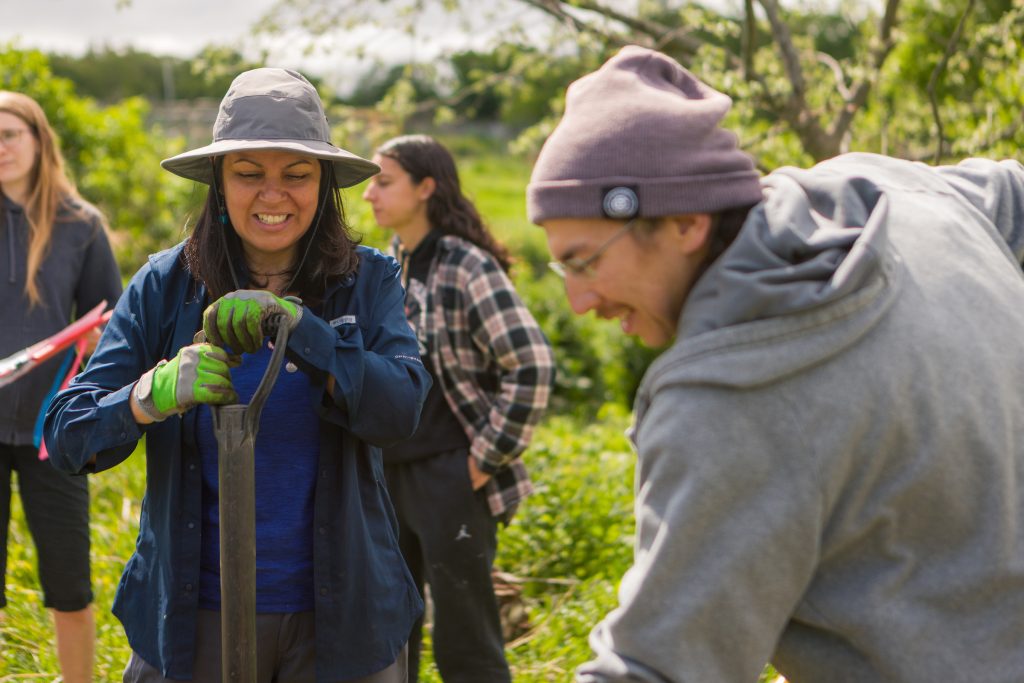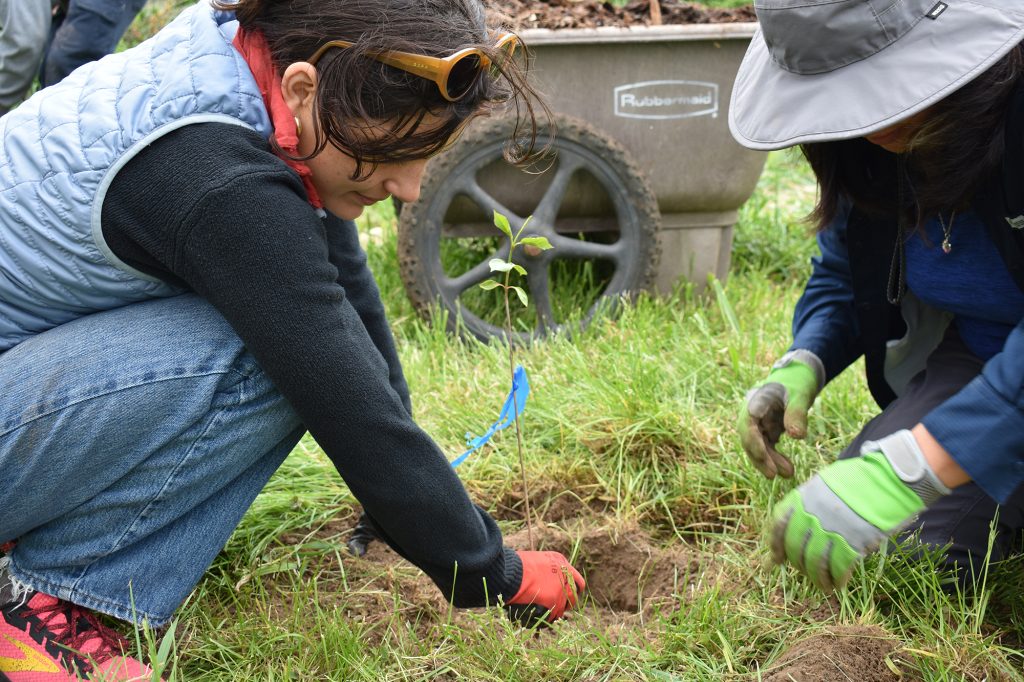This spring, community members came together to plant a food forest at the UW Student Organic Farm.
By Audra Koscik

On a brisk May morning, a small group gathered at the UW Student Organic Farm. With shovels, dirt, water, and saplings in hand, they prepared to plant the beginnings of a food forest.
Food forests are unique food systems. When people think of agricultural landscapes, they often imagine fields with rows and rows of crops. Food forests provide an alternative option by integrating a diversity of crops including fruits, nuts, vegetables, herbs, and even fungi.
Ella DeRosier, who recently graduated from the University of Wisconsin–Madison, was interested in growing a food forest on campus.

Starting a food forest is no easy task. It requires enough land for various trees, shrubs, and plants; knowledge on how to weave together different species to create an ecosystem; and labor to raise and nurture the forest.
DeRosier worked with Malachi Persche, manager of the Dining and Culinary Services (DCS) portion of the UW Student Organic Farm, to kick-start the project. They reached out to leaders in the College of Agricultural and Life Sciences (CALS) for interest and support. Through this, they connected with Claudia Irene Calderón, a teaching faculty in plant and agroecosystem sciences and Violeta Calderon, an agroecology graduate student co-advised by Calderón and Annie Jones.
Violeta Calderon was particularly interested. “Having lived in Madison my whole life, I think there is a lot of potential for food forests here,” she says. “I believe in the possibilities so much that as part of my project in the Agroecology program, I have been collaborating with community members and local organizations to promote food forests and assess the possibilities for establishing new food forests in Madison and Dane County more broadly.”

Food forests have many benefits to people and to the environment. “While it takes a lot of time and effort to establish a food forest in the beginning stages, eventually the garden will become a self-sustaining ecosystem that requires less maintenance,” explains Calderon.
Once established, food forests often are more resilient to climate change. This is because many of the crops are native or locally adapted species, meaning they are better acclimated to extreme weather caused by climate change, says Calderon.
Food forests have deep roots in history. “The practice of maintaining forest gardens as a source for food, medicine, and materials has existed around the world for thousands of years,” explains Calderon. “However, those practices were greatly disrupted by the impacts of colonization and industrial agriculture.” People are beginning to plant more food forests though, as they realize their benefits such as increasing food security, restoring biodiversity, and promoting healthier diets, says Calderon.

Claudia Irene Calderón was interested in the research and education a food forest on campus could provide. The forest could potentially be used for undergraduate and graduate student research, course field trips and projects, and as a space to connect different scientific disciplines. “The food forest has a tremendous educational potential as an outdoor classroom and an engaging, hands-on living laboratory,” she says.
Calderón has already connected with faculty in soil sciences, plant and agroecosystem sciences, landscape architecture, and forest and wildlife ecology. “The rationale for casting a broad net to connect people to the food forest is to engage more people with the learning potential that this space can have,” she says.
DeRosier conducted extensive research when designing the food forest both by reviewing written work and by connecting with local experts. She was interested in planting American plums, pawpaw, aronias, hazelnuts, berries, hopniss, ramps, and asparagus. She also wanted to incorporate plants already on the land into the design. The food forest sits adjacent to the Eagle Heights Community Gardens within the Lakeshore Nature Preserve. She made sure to keep any existing perennial crops that were planted by previous stewards of the plot.

In May, DeRosier, Claudia Irene Calderón, Violeta Calderon, and volunteers gathered to break ground for the food forest at the UW Student Farm. They dug holes for the new saplings, carefully filled each of these cradles with soil and compost, covered the base with mulch, and watered the plants in. After a morning of planting, they established the beginning of a new forest.
This food forest will support the community for years to come. Unlike agricultural fields where many crops must be replanted each year, food forests are ecosystems that should withstand the test of time.
“I’m hoping that the food forest will have reached maturity, and that you can walk through it like a normal forest,” says DeRosier. “I’m hoping that when people walk through it they are inspired by how nature can sustain them. Most of all, I am hoping that the food forest can be a good example of how agriculture can be a practice of community that brings together people and our ecosystems.”
Interested in supporting this food forest? There will be another planting day event at Eagle Heights Community Gardens on Sunday, September 21st.
